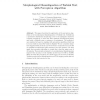Free Online Productivity Tools
i2Speak
i2Symbol
i2OCR
iTex2Img
iWeb2Print
iWeb2Shot
i2Type
iPdf2Split
iPdf2Merge
i2Bopomofo
i2Arabic
i2Style
i2Image
i2PDF
iLatex2Rtf
Sci2ools
CICLING
2007
Springer
2007
Springer
Morphological Disambiguation of Turkish Text with Perceptron Algorithm
Abstract. This paper describes the application of the perceptron algorithm to the morphological disambiguation of Turkish text. Turkish has a productive derivational morphology. Due to the ambiguity caused by complex morphology, a word may have multiple morphological parses, each with a different stem or sequence of morphemes. The methodology employed is based on ranking with perceptron algorithm which has been successful in some NLP tasks in English. We use a baseline statistical trigram-based model of a previous work to enumerate an n-best list of candidate morphological parse sequences for each sentence. We then apply the perceptron algorithm to rerank the n-best list using a set of 23 features. The perceptron trained to do morphological disambiguation improves the accuracy of the baseline model from 93.61% to 96.80%. When we train the perceptron as a POS tagger, the accuracy is 98.27%. Turkish morphological disambiguation and POS tagging results that we obtained is the best report...
CICLING 2007 | Morphological Disambiguation | Morphological Parse | Natural Language Processing | Perceptron Algorithm |
| Added | 07 Jun 2010 |
| Updated | 07 Jun 2010 |
| Type | Conference |
| Year | 2007 |
| Where | CICLING |
| Authors | Hasim Sak, Tunga Güngör, Murat Saraclar |
Comments (0)

